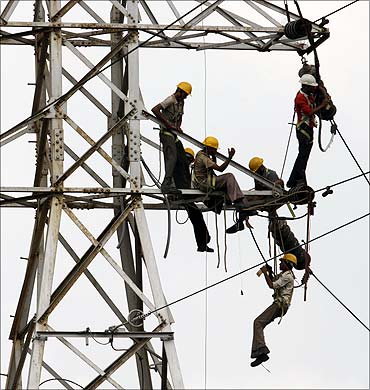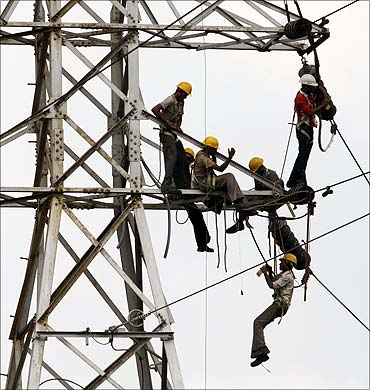With their balance sheets under stress, private companies have lost interest in power projects.
 At Rs 1.19 a unit, power generated from the Sasan ultra mega power project (UMPP) in Madhya Pradesh is perhaps one of the cheapest in the country.
At Rs 1.19 a unit, power generated from the Sasan ultra mega power project (UMPP) in Madhya Pradesh is perhaps one of the cheapest in the country.
Yet, Reliance Power wants state-owned Power Finance Corporation to buy it for "breach of representation" - the de-allocation of the Chhatrasal coal block, which was linked to the project.
The company has already given up the Tilaiya UMPP because of the slow pace of land acquisition by the Jharkhand government and has not made progress on the Krishnapatnam UMPP in Tamil Nadu.
Tata Power's UMPP at Mundra in Gujarat, based on imported coal is in financial trouble for selling power at Rs 2.26 a unit.
That's not all. The Union government had to cancel the two-year long bidding process for two UMPPs in Tamil Nadu and Odisha after all private companies pulled out and government-controlled NTPC and NHPC emerged as the winning bidders.
For the Tamil Nadu UMPP, Adani Power, CLP India, Jindal Steel & Power, JSW Energy, Sterlite Energy and Tata Power were in the fray, but only four of them bought the 'request for proposal' document and none decided to proceed further. NTPC submitted its bid, which wasn't opened since it was felt that at least three quotes should be available for choosing the final winner.
Similarly, the Odisha UMPP saw nine interested bidders but finally only NTPC and NHPC were left as the rest pulled out, which led to the cancellation of the auction.

Despite Mundra and Sasan producing 8,000 Mw of power, the inescapable inference is that the UMPP experiment, launched with much fanfare during the first tenure of the Manmohan Singh-led United Progressive Alliance government, has failed.
RV Shahi, the former Union power secretary who played a critical role in drawing up the UMPP blueprint, rejects outright that the model is at fault. "Two projects are running successfully," he says. According to him, the key innovation in the UMPP plan was to reduce the pre-construction risks of signing power purchase agreements (PPAs), getting land and other clearances before inviting competitive bids.
Shahi says problems arise when these risks are not taken care of, like in the case of Tilaiya. "The confidence of bankers and promoters gets shaken," he says.
Lack of confidence is, however, not the only thing which has happened since 2007 when the first lot of UMPPs was given out. The power sector itself has changed with large power companies having over-leveraged balance sheets that cannot take on more capital expenditure.
Kameswara Rao, leader (power and utilities), PricewaterhouseCoopers, says most projects based on overseas coal and domestic coal block allocation have suffered, and the UMPPs are no exception. In fact, they have fared better than other recent thermal projects.
"But there are lessons for both the government and private investors. Policy stability and project preparedness are necessary, which the previous model has not delivered," says he. "On their part, some bidders underestimated development risks, and banked on upsides that didn't come through."
As an industry expert points out, Reliance Power's low tariff for Sasan should be seen in the context that any company will bid low because of the benefits it sees coming from other factors.
In this case, the company bid a low tariff in anticipation of extra coal but now when that benefit is no longer available, it may not want to continue supplying power at the same price.
Tweaking rules
While putting the UMPPs on hold, the government decided to come out with a fresh draft for bidding. An expert committee was set up for the purpose. According to India Ratings, the proposed changes could increase developer interest in UMPPs as they try to address the concerns of investors and lenders on the previous guidelines. These guidelines cover risk areas including fuel price variation, fixed charge quote, ownership of asset, incentives for performance, land acquisition and termination of contract.
"The key reason for the failure of the previous bidding guidelines was the unwillingness of lenders to fund a 4,000 Mw power project with an estimated investment outlay of Rs 20,000 crore (Rs 200 billion) on a design, build, finance, operate and transfer model where the asset ownership did not vest with the developer. The current guidelines propose a build, own and operate model which will result in greater acceptance from lenders for financing," said India Ratings in a report.
Besides, the guidelines provide for better fuel cost pass-through as they envisage full escalation on the base tariff based on the Central Electricity Regulatory Commission (CERC) norms.
Earlier, a fuel cost bid was divided into two parts which required the developer to project the fixed part of the fuel cost over the life of the project, leading to viability issues. Escalations based on the CERC norms should provide sufficient cushion to developers to manage the inflation associated with mining costs.
The draft norms also propose a segregation of operating and infrastructure assets into two separate special purpose vehicles (SPVs). The land for the coal block as well as the power plant would be housed under an infra SPV, while the plant would be developed under an operating SPV.
"The move will lead to the mortgage of land and power asset separately to raise money; however, this could pose challenges in the sale of asset," India Ratings said.
Though the draft is yet to be given a final shape, another crucial issue that will need to be decided before the companies bid for another round of UMPPs is whether the sluggish market is good enough for such large projects. At a time when existing generation capacities are running low, is it prudent enough to put up large projects?
Shahi dismisses any suggestion for a need to pause here. According to him, mega projects give economies of scale. "Four years have already been wasted. Capacity addition has been good in the last few years because of action taken in the past, but for the last two years or so, there has been nil project activity which will impact capacity addition."
Unless the balance sheets of private power companies improve, however, UMPPs will remain a pipe dream.









